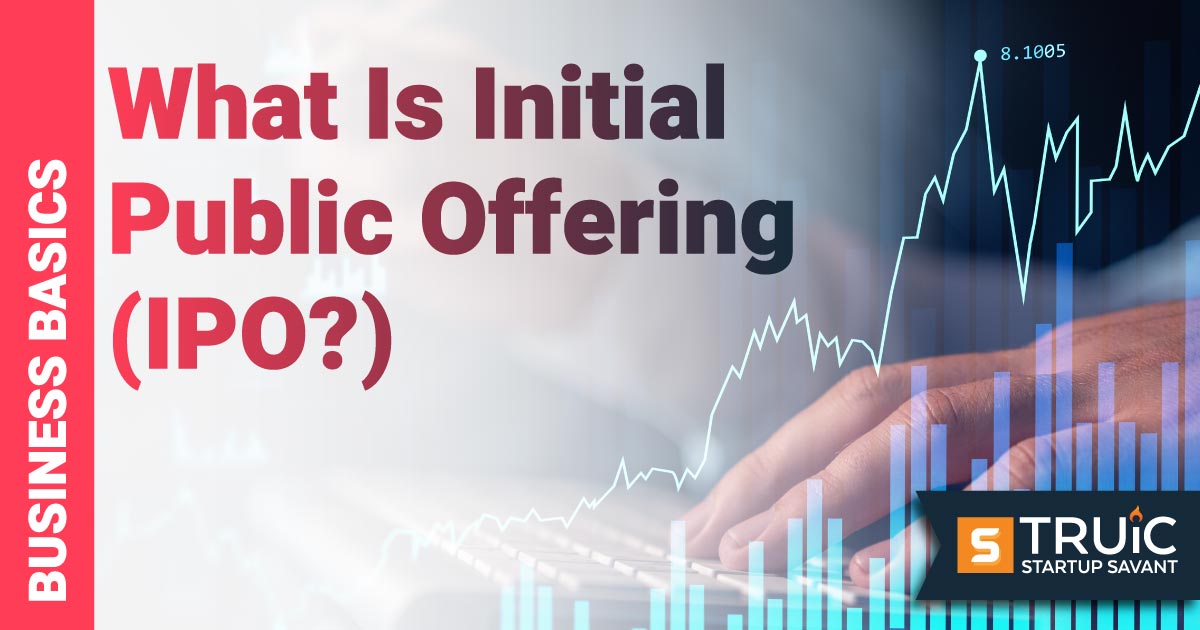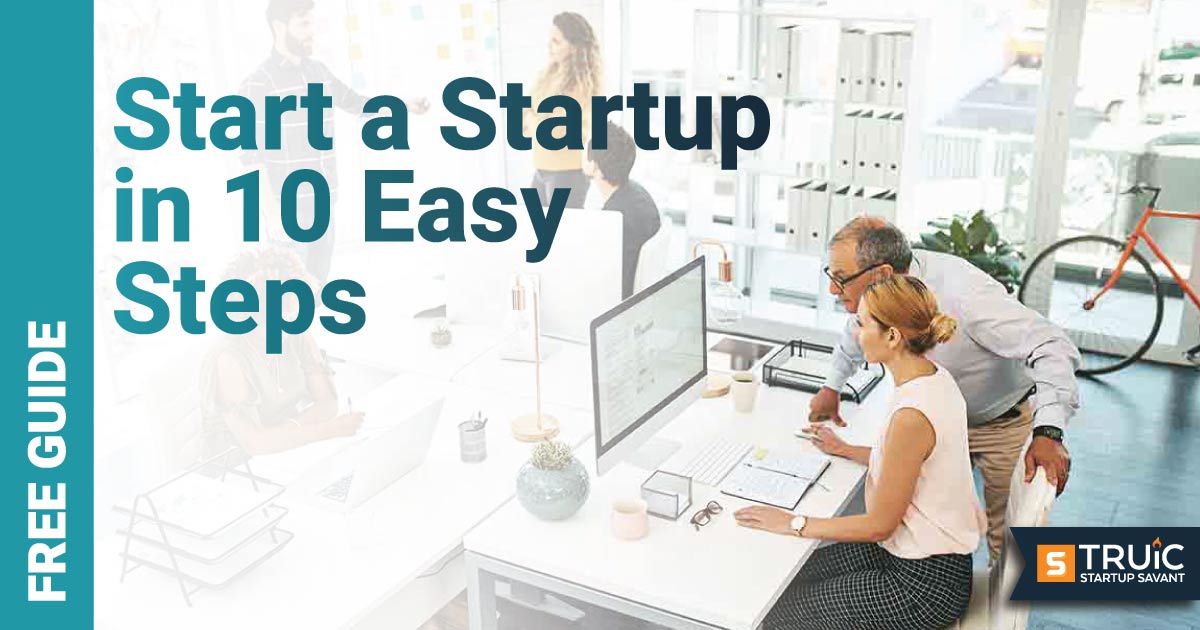What Is an IPO (Initial Public Offering)?

Last Updated: By TRUiC Team
“Initial Public Offering.” “IPO.” “Going Public.” Some consider IPOs to be the gold standard in startup exits, but others may find the term confusing.
If you’ve ever asked yourself, “what is an IPO” or “how does it work,” you’ve come to the right place. This article covers how IPOs work, their pros and cons, and some examples of famous IPOs.
Skip Ahead:
What Is an IPO?
An initial public offering, or IPO for short, is the process of taking the company public by selling shares on the publicly traded market. The IPO is the first (or initial) sale of a company’s shares to the public.
To carry out an IPO, companies work with investment banks and attorneys to file with the US Securities and Exchange Commission (SEC) and meet the regulatory requirements to allow a company's shares (or stock) to be traded on the public market.
What Is the Purpose of an IPO?
There may be several reasons that a company decides to go public and issue an IPO. In many cases, companies that decide to go public are strong, fast-growing businesses that want to raise capital to fund growth or pay down debt. IPOs can infuse huge amounts of capital into a company, allowing them to focus on expansion, growth, or even acquisitions.
Another reason that companies may decide to go public is to provide liquidity for its stakeholders. Investors, founders, and early employees all invest their money and time in the hopes of cashing out someday. Investors particularly may expect it. An IPO provides that liquidity. It is much more difficult to find investors for a private company than a public one in which the shares can be traded on the open market.
Finally, a company may decide to go public for the reputation and recognition that comes along with being a publicly-traded company. Being publicly traded brings both legitimacy and transparency, raising the company's profile as a serious business.
How Does an IPO Work?
The IPO process is long and complex. A startup will need to choose and work with investment bankers and attorneys to make regulatory filings with the SEC, decide how many shares it will sell for its IPO, what price it will sell at, and who to sell them to.
Once shares go on sale and begin trading publicly, a previously privately-held company will become a publicly-traded company. Founders and other shareholders can then sell their shares on the market, effectively exiting (or at least ending their ownership of) a startup if they wish. This is how founders, investors, and early employees often cash out on their investments. However, it is important to note that in many cases, there is usually a lock-out period where management and employees cannot sell their shares for a certain amount of time (usually 90 to 180 days).
The IPO Process
The IPO process begins when a company decides that it wants to go public. The first thing a company needs to do is to get its financial records in order and choose an investment bank to partner with to underwrite the IPO. The underwriters will then conduct due diligence, draft the required application materials, meet and present the company to potential institutional investors, set an initial price, and facilitate the release of shares to the public.
Here is how the process works:
Choose an Underwriter
The first thing a company needs to do to issue an IPO is to choose and partner with an investment bank to act as underwriter. The underwriters then work with the company to perform due diligence, prepare the company’s IPO application with the SEC, determine the initial price, and buy the initial shares from the company to sell to the public.
Due Diligence
Once a company chooses an investment bank, the underwriters and attorneys will conduct a thorough due diligence. During their due diligence the underwriters and lawyers investigate the company’s financials, regulatory compliance, existing practices, challenges, and risks.
File With the SEC for an IPO
With due diligence complete, the startup and IPO team will need to submit the required filings for the IPO. This includes a Form S-1 filing, or IPO prospectus, with the Securities and Exchange Commission (SEC), along with any additional required such as a letter of intent and Red Herring document.
These filings should contain everything that potential investors should know about the company in order to make a sound investment decision, such as financial performance and factors affecting risk.
Put on an IPO Roadshow
After all required filings are complete, the IPO team will then put on an IPO roadshow. An IPO roadshow is when the company’s executive and the IPO team meet and present the company and the opportunity to institutional investors to estimate interest and an initial price.
Pricing
Following SEC approval and assessing the interest of institutional investors, the IPO team will then set a price. The price is set based on several factors, including the company's up-to-date financials, industry baselines and multiples, and investor interest.
Going Public
When the IPO is ready to launch, the shares are sold to a group of investors (usually institutional investors) at the predetermined price, and, prior to the IPO, an auction is held to determine the initial listing price. The stock is then released to the public.
Stabilization
Following an IPO, the underwriters are permitted to buy and sell shares during a stabilization period in order to attempt to stabilize the price. While several strategies can be used to influence the price, stabilization periods, or quiet periods, only last 25 days, meaning there is limited opportunity for investment bankers to continue to influence the price.
Transition
Once the stabilization period ends, a company’s stock will enter a transition period. During this period, underwriters and others can do little to influence a company’s stock price and valuation, and the market is left to decide the price for subsequent release of stock and raising of capital.
IPO Documents
There are a number of documents startup owners should be familiar with that will be required to launch an IPO. These include documents needed to contract with the underwriters and investment bankers, documents the underwriters will draft, and documents required by the SEC.
First, startups will have to contract with an underwriter(s). The underwriters must finalize several documents, including:
- Preliminary Prospectus: The prospectus is a document required by the SEC that will contain everything that an investor would need to know in order to make a decision to invest. This will include the company’s financials, as well as any other information such as any associated risks.
- Firm Commitment: A firm commitment agreement is an agreement between a company and its underwriters that the underwriter will purchase the entirety of shares that are being released by the startup and resell them on the public market.
- Best Efforts: A best efforts agreement stipulates that, while an underwriter will not guarantee a specific price or a minimum raise, they will put forth their best efforts and do whatever it takes to sell the shares on behalf of the listing company.
Next, the underwriter will draft several documents, including:
- Engagement Letter: An engagement letter or engagement agreement outlines the terms of the agreement between an issuing company and its underwriters.This will include the underwriting discount, as well as any other terms and conditions of the underwriting agreement.
- Letter of Intent: A letter of intent (LOI) defines the commitment of the company to be forthcoming and provide all necessary information and the commitment of the underwriters to carry out their duties as the allotment or allotment option that the underwriters will receive.
- Red Herring Document: A red herring prospectus is a preliminary final prospectus that includes everything that will be in the final prospectus except for the number of shares and share price.
Finally, the underwriter will draft Form S-1: Registration Statement, the required filing for the SEC. An S-1 Registration Statement is the primary application document for applying for an IPO with the SEC. The S-1 Registration Statement will contain the prospectus, as well as any private information that does not need to be disclosed in the prospectus but is required by the SEC.
Alternatives
Although there are several alternatives for startup exits (e.g., sales, acquisitions, mergers, etc.), there are actually even several alternatives to IPOs for startups that want to go public. Two of the most popular are direct listing and SPACs. Each come with their own rules and restrictions, but startup founders should understand each as they evaluate their alternatives.
Direct Listing
Direct listing is an increasingly popular alternative to an IPO. A direct listing is similar to an IPO in that it is the first offering of shares to the public.
Unlike in an IPO, there are no predetermined initial prices in a direct listing. Rather, in a direct listing, there is an opening public auction in which shares are offered to the public market, and the market sets the initial share price.
Several notable companies have gone public via direct listing, including Coinbase, Roblox, and Spotify.
SPACs
Another vehicle for startup exits growing in popularity are special purpose acquisition companies (SPACs). SPACs are companies created with the purpose of finding a company to buy and bring public.
In a SPAC deal, SPACs themselves launch an IPO to raise funds in order to buy a startup or other company. Once they have gone public and launched an IPO, SPACs then find a target company and work with that company to acquire it, effectively merging the startup with the SPAC and providing the startup with the SPACs public listing.
SPACs are currently one of the hottest trends on Wall Street and have become an increasingly common startup exit vehicle. Although SPACs have been around for a while (since the 1990s), they have recently caught fire as more than 200 SPACs were launched in 2020 alone.
Well-known companies that have recently gone public through SPACs include DraftKings, Nikola Corporation, and Virgin Galactic.
IPO Advantages and Disadvantages
When considering whether a startup should position itself to launch an IPO, it is important to consider both the advantages and disadvantages in order to find what is best for both owner and startup.
IPO Advantages
IPOs are considered by some as the gold standard in startup exits. Successful IPOs can raise significant amounts of capital and provide an avenue for founders and investors to cash in on their investments.
Some of the top advantages of “going public” and launching an IPO include:
- Usually produces the highest return
- Raises significant capital for the startup
- Money to scale and grow
- Reduces the cost of future capital
- Increased reputation and recognition
- Increased sales and profits
- Can use stock to attract talent and compensate employees
IPO Disadvantages
As appealing as IPOs may seem like a vehicle to raise capital and provide an avenue for startup exit, there are also several risks and drawbacks. IPOs never materialize for many companies, and others fail to garner strong valuations. Public companies are also subject to much more scrutiny than private companies, as regulatory bodies, shareholders, and others will now influence the decision-making process. Here are some of the potential disadvantages to releasing an IPO:
- Long and complex process
- High underwriter and attorney costs
- Regulatory, filing, and reporting requirements
- Mandatory transparency of finances
- Scrutiny from regulators and shareholders
- Small number of IPOs succeed
- Lock-out period restricts when founders and employees can sell stock or options
IPO Examples
The majority of public companies, those listed on a stock exchange and sold on the public market, have gone through an IPO. Here are some of the more well-known companies and how they performed at and after their initial public offering:
Google IPO
Google’s IPO took place way back on March 30, 2004. With an initial price of $85 per share, Google ended its first day on the market with a valuation of $23 billion. In the 18 years since, Google’s value has compounded time and time again.
In 2014, Google reorganized as Alphabet, splitting its existing stock two-for-one. As of early 2022, Alphabet (Google) is trading at $2,894 per share with a market value of $1.92 trillion.
Tesla IPO
Tesla held an initial public offering on June 29, 2010, at the initial price of $17 per share and an end-of-day price of $23.89, giving Tesla an overall value of $2.2 billion. Tesla has only grown over the past 10 years —- as of January 1, 2022, Tesla is trading at $930 per share with a market value of $1.06 trillion.
Facebook IPO
Facebook held its initial public offering on May 18, 2012. With an initial price of $38 per share, Facebook ended its first day at only $38.23 per share and a market valuation of $90 billion. The proceeding month didn’t get any better, trading as low as $27.72 by June 1, 2012.
Despite some early disappointment, Facebook has only grown in the nearly 10 years since then. Facebook, now preferring to be known as Meta, opened 2022 trading at $300.50 per share with a market value of $935.65 billion, more than 10 times their original valuation back in 2012.
Uber IPO
Uber’s IPO took place on May 9, 2019. Trading at an initial price of $45, Uber ended its first day on the public market at a per-share price of $42 — down 7% from its initial price — and a valuation of $68.52 billion. While Uber's price and valuation have fluctuated, it began 2022 trading at $36.28 per share with a market value of $81.35 billion.
Airbnb IPO
Airbnb’s initial public offering took place on December 10, 2020. Airbnb priced its IPO at $68 a share, selling 51.5 million shares and raising $3.5 billion, with an end-of-day value of $47 billion. Airbnb ended 2020 with the largest valuation of the year.
Even in the midst of the COVID-19 pandemic, Airbnb has performed well in the year since. As of the beginning of 2022, Airbnb is trading at $166 per share with a market cap of $105.8 billion.
Frequently Asked Questions
What does it mean when a company files for an IPO?
When a company files for an IPO, they announce their plans to “take the company public” through the IPO process.
Who is a part of the IPO team?
Startups typically assemble a team to work on the details and requirements of leading a company through the IPO process. The IPO team usually consists of the company’s executives as well as underwriters, attorneys, and accountants.
What is an underwriter and how do you choose one to work with?
An IPO underwriter is an investment bank that provides underwriting services for companies undertaking the IPO process. Underwriters are the most important figure in the IPO process; thus, choosing the right underwriter is important.
When choosing an underwriter, it’s important to research the investment banker’s reputation and previous success. Other considerations include the quality of the team, how well they understand the business, and how they plan on telling and selling the startup’s story to investors.
Who sets the IPO price?
The underwriter (or investment banker) sets the IPO price. A company will decide how many shares it wants to release, and the investment bank will gauge investor interest and perform a valuation to determine the initial price.
Are there other ways of taking a company public?
Yes, there are several alternatives for taking a company public. An IPO is one alternative. Other alternatives include direct listing, which follows a different process than IPOs, and SPACs (special purpose acquisition companies). SPACs are companies that go public with the sole purpose of merging with a private company to take it public.
Is an initial public offering a primary or a secondary offering?
An IPO is a primary investment offering. Primary offerings are when shares are offered and purchased directly from the issuer. In an IPO, investors are purchasing shares directly from the company through its underwriters and investment banking partners.
On the other hand, secondary offerings are when shares are offered and purchased from other sources such as investors, employees, or other shareholders.
How long is the IPO process?
The IPO process can be long and complex, with the quickest IPOs completed in four to six months and many IPOs taking 12 months or more from start to finish. One of the longest parts of the process can be auditing company finances. A company then has to prepare its registration documents and file the required application materials with the SEC to be reviewed.


